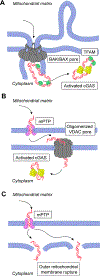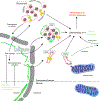Cytoplasmic DNA: sources, sensing, and role in aging and disease
- PMID: 34715021
- PMCID: PMC8627867
- DOI: 10.1016/j.cell.2021.09.034
Cytoplasmic DNA: sources, sensing, and role in aging and disease
Abstract
Endogenous cytoplasmic DNA (cytoDNA) species are emerging as key mediators of inflammation in diverse physiological and pathological contexts. Although the role of endogenous cytoDNA in innate immune activation is well established, the cytoDNA species themselves are often poorly characterized and difficult to distinguish, and their mechanisms of formation, scope of function and contribution to disease are incompletely understood. Here, we summarize current knowledge in this rapidly progressing field with emphases on similarities and differences between distinct cytoDNAs, their underlying molecular mechanisms of formation and function, interactions between cytoDNA pathways, and therapeutic opportunities in the treatment of age-associated diseases.
Keywords: aging; cancer; cytoplasmic DNA; cytoplasmic chromatin fragment; micronucleus; mitochondrial DNA; retrotransposon; senescence.
Copyright © 2021. Published by Elsevier Inc.
Conflict of interest statement
Declaration of interests The authors declare no competing interests.
Figures





References
Publication types
MeSH terms
Substances
Grants and funding
LinkOut - more resources
Full Text Sources
Medical

